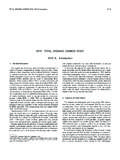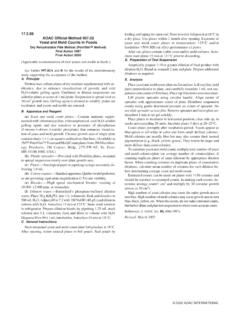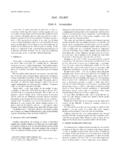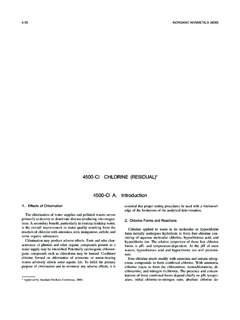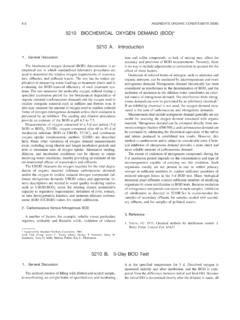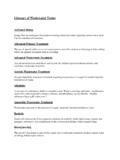Transcription of 5220 CHEMICAL OXYGEN DEMAND (COD)* 5220 …
1 5-14 AGGREGATE ORGANIC CONSTITUENTS (5000). 5220 chemical oxygen demand (COD)*. 5220 A. Introduction CHEMICAL OXYGEN DEMAND (COD) is defined as the amount of a The most common interferent is the chloride ion. Chloride reacts specified oxidant that reacts with the sample under controlled con- with silver ion to precipitate silver chloride, and thus inhibits the ditions. The quantity of oxidant consumed is expressed in terms of catalytic activity of silver. Bromide, iodide, and any other reagent its OXYGEN equivalence. Because of its unique CHEMICAL properties, that inactivates the silver ion can interfere similarly. Such interfer- the dichromate ion (Cr2O72 ) is the specified oxidant in Methods ences are negative in that they tend to restrict the oxidizing action of 5220B, C, and D; it is reduced to the chromic ion (Cr3 ) in these the dichromate ion itself.
2 However, under the rigorous digestion tests. Both organic and inorganic components of a sample are procedures for COD analyses, chloride, bromide, or iodide can react subject to oxidation, but in most cases the organic component with dichromate to produce the elemental form of the halogen and predominates and is of the greater interest. If it is desired to measure the chromic ion. Results then are in error on the high side. The either organic or inorganic COD alone, additional steps not de- difficulties caused by the presence of the chloride can be overcome scribed here must be taken to distinguish one from the other. COD largely, though not completely, by complexing with mercuric sul- is a defined test; the extent of sample oxidation can be affected by fate (HgSO4) before the refluxing procedure.
3 Although 1 g HgSO4. digestion time, reagent strength, and sample COD concentration. is specified for 50 mL sample, a lesser amount may be used where COD often is used as a measurement of pollutants in wastewater sample chloride concentration is known to be less than 2000 mg/L, and natural waters. Other related analytical values are biochemical as long as a 10:1 weight ratio of HgSO4:Cl is maintained. Do not OXYGEN DEMAND (BOD), total organic carbon (TOC), and total use the test for samples containing more than 2000 mg Cl /L. OXYGEN DEMAND (TOD). In many cases it is possible to correlate two Techniques designed to measure COD in saline waters are or more of these values for a given sample.
4 BOD is a measure of ,2. OXYGEN consumed by microorganisms under specific conditions; Halide interferences may be removed by precipitation with TOC is a measure of organic carbon in a sample; TOD is a measure silver ion and filtration before digestion. This approach may of the amount of OXYGEN consumed by all elements in a sample introduce substantial errors due to the occlusion and carrydown when complete (total) oxidation is achieved. of COD matter from heterogenous samples. In a COD analysis, hazardous wastes of mercury, hexavalent Ammonia and its derivatives, in the waste or generated from chromium, sulfuric acid, silver, and acids are generated. Meth- nitrogen-containing organic matter, are not oxidized.
5 However, ods 5220C and D reduce these waste problems but may be less elemental chlorine reacts with these compounds. Hence, correc- accurate and less representative. (See 2 below.) tions for chloride interferences are difficult. Nitrite (NO2 ) exerts a COD of mg O2/mg NO2 -N. 1. Selection of Method Because concentrations of NO2 in waters rarely exceed 1 or 2. mg NO2 -N/L, the interference is considered insignificant and The open reflux method (B) is suitable for a wide range of wastes usually is ignored. To eliminate a significant interference due to where a large sample size is preferred. The closed reflux methods (C NO2 , add 10 mg sulfamic acid for each mg NO2 -N present in and D) are more economical in the use of metallic salt reagents and the sample volume used; add the same amount of sulfamic acid generate smaller quantities of hazardous waste, but require homog- to the reflux vessel containing the distilled water blank.
6 Enization of samples containing suspended solids to obtain repro- Reduced inorganic species such as ferrous iron, sulfide, man- ducible results. Ampules and culture tubes with premeasured re- ganous manganese, etc., are oxidized quantitatively under the agents are available commercially. Measurements of sample vol- test conditions. For samples containing significant levels of these umes as well as reagent volumes and concentrations are critical. species, stoichiometric oxidation can be assumed from known Consequently, obtain specifications as to limits of error for pre- initial concentration of the interfering species and corrections mixed reagents from manufacturer before use.
7 Can be made to the COD value obtained. Determine COD values of 50 mg O2/L by using procedures The silver, hexavalent chromium, and mercury salts used in , , or Use procedure to determine, the COD determinations create hazardous wastes. The greatest with lesser accuracy, COD values from 5 to 50 mg O2/L. problem is in the use of mercury. If the chloride contribution to COD is negligible, HgSO4 can be omitted. Smaller sample sizes 2. Interferences and Limitations (see 5220C and D) reduce the waste. Recovery of the waste material may be feasible if allowed by regulatory Oxidation of most organic compounds is 95 to 100% of the theoretical value. Pyridine and related compounds resist oxidation 3.
8 Sampling and Storage and volatile organic compounds will react in proportion to their contact with the oxidant. Straight-chain aliphatic compounds are oxidized more effectively in the presence of a silver sulfate catalyst. Preferably collect samples in glass bottles. Test unstable sam- ples without delay. If delay before analysis is unavoidable, preserve sample by acidification to pH 2 using conc H2SO4. Blend (homogenize) all samples containing suspended solids * Approved by Standard Methods Committee, 1997. Joint Task Group: 20th Edition Clarence G. Johnson (chair), Donald G. Miller, before analysis. If COD is to be related to BOD, TOC, etc., John T. Pivinski.
9 Ensure that all tests receive identical pretreatment. Make prelim- CHEMICAL OXYGEN DEMAND (COD) (5220)/Open Reflux Method 5-15. inary dilutions for wastes containing a high COD to reduce the 2. BAUMANN, 1974. Dichromate reflux CHEMICAL OXYGEN DEMAND : A. error inherent in measuring small sample volumes. proposed method for chloride correction in highly saline waters. Anal. Chem. 46:1336. 4. References 3. HOLM, 1996. Treatment of Spent CHEMICAL OXYGEN DEMAND Solutions for Safe Disposal. Illinois State Water Survey, Champaign. 1. BURNS, & C. MARSHALL. 1965. Correction for chloride interfer- ence in the CHEMICAL OXYGEN DEMAND test. J. Water Pollut. Control Fed.
10 37:1716. 5220 B. Open Reflux Method 1. General Discussion d. Standard ferrous ammonium sulfate (FAS) titrant, approx- imately : Dissolve 98 g Fe(NH4)2(SO4)2 6H2O in dis- a. Principle: Most types of organic matter are oxidized by a tilled water. Add 20 mL conc H2SO4, cool, and dilute to 1000. boiling mixture of chromic and sulfuric acids. A sample is mL. Standardize this solution daily against standard K2Cr2O7. refluxed in strongly acid solution with a known excess of potas- solution as follows: sium dichromate (K2Cr2O7). After digestion, the remaining un- Dilute mL standard K2Cr2O7 to about 100 mL. Add 30. reduced K2Cr2O7 is titrated with ferrous ammonium sulfate to mL conc H2SO4 and cool.
